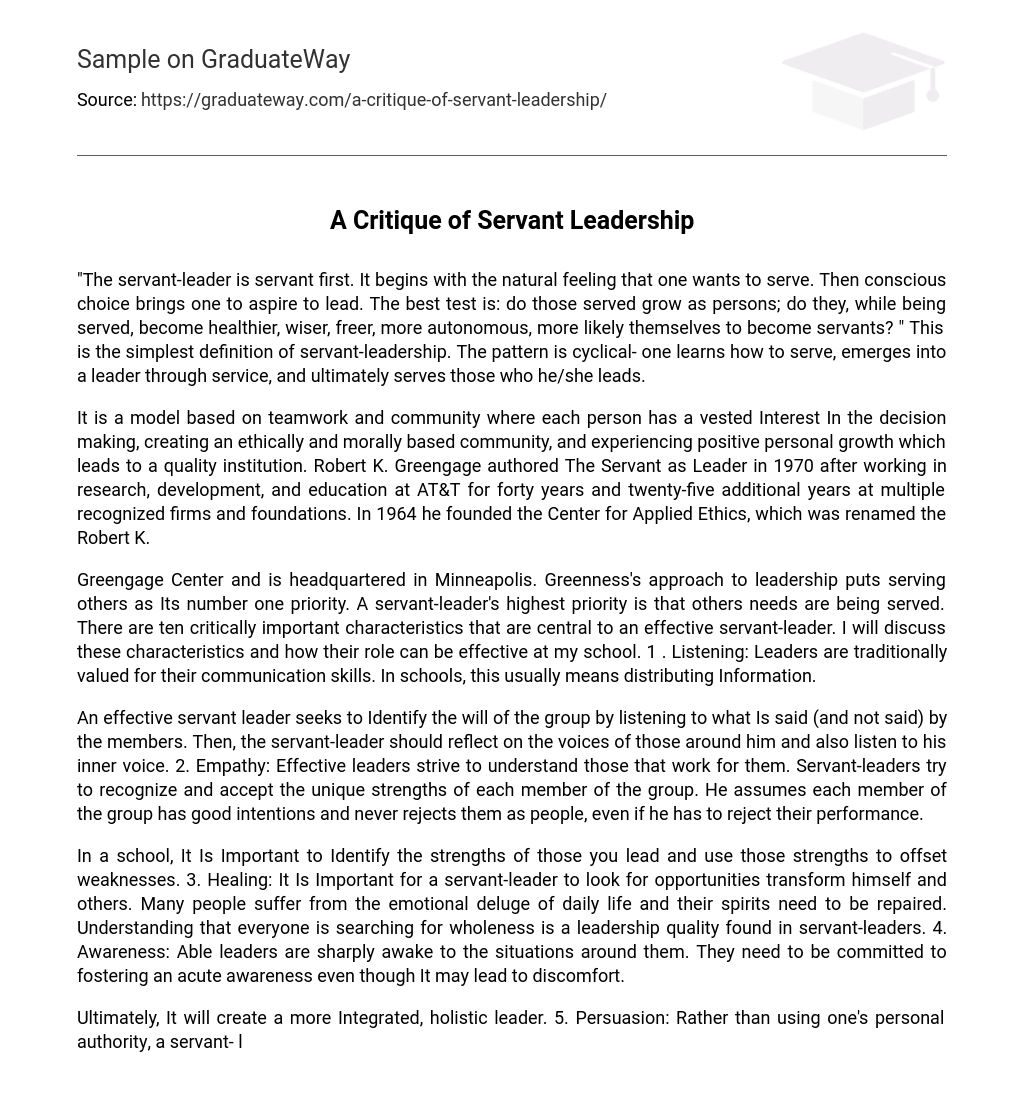“The servant-leader is servant first. It begins with the natural feeling that one wants to serve. Then conscious choice brings one to aspire to lead. The best test is: do those served grow as persons; do they, while being served, become healthier, wiser, freer, more autonomous, more likely themselves to become servants? ” This is the simplest definition of servant-leadership. The pattern is cyclical- one learns how to serve, emerges into a leader through service, and ultimately serves those who he/she leads.
It is a model based on teamwork and community where each person has a vested Interest In the decision making, creating an ethically and morally based community, and experiencing positive personal growth which leads to a quality institution. Robert K. Greengage authored The Servant as Leader in 1970 after working in research, development, and education at AT&T for forty years and twenty-five additional years at multiple recognized firms and foundations. In 1964 he founded the Center for Applied Ethics, which was renamed the Robert K.
Greengage Center and is headquartered in Minneapolis. Greenness’s approach to leadership puts serving others as Its number one priority. A servant-leader’s highest priority is that others needs are being served. There are ten critically important characteristics that are central to an effective servant-leader. I will discuss these characteristics and how their role can be effective at my school. 1 . Listening: Leaders are traditionally valued for their communication skills. In schools, this usually means distributing Information.
An effective servant leader seeks to Identify the will of the group by listening to what Is said (and not said) by the members. Then, the servant-leader should reflect on the voices of those around him and also listen to his inner voice. 2. Empathy: Effective leaders strive to understand those that work for them. Servant-leaders try to recognize and accept the unique strengths of each member of the group. He assumes each member of the group has good intentions and never rejects them as people, even if he has to reject their performance.
In a school, It Is Important to Identify the strengths of those you lead and use those strengths to offset weaknesses. 3. Healing: It Is Important for a servant-leader to look for opportunities transform himself and others. Many people suffer from the emotional deluge of daily life and their spirits need to be repaired. Understanding that everyone is searching for wholeness is a leadership quality found in servant-leaders. 4. Awareness: Able leaders are sharply awake to the situations around them. They need to be committed to fostering an acute awareness even though It may lead to discomfort.
Ultimately, It will create a more Integrated, holistic leader. 5. Persuasion: Rather than using one’s personal authority, a servant- leader primarily relies on the power of persuasion. Convincing others as opposed to origin compliance offers one of the clearest distinctions between authoritarian models of leadership and servant-leadership. Leaders who have the ability to persuade are much more effective at building a consensus within a group, which is very effective In an educational setting. 6. Conceptualization: Good leaders have the concepts and goals for their schools. . Foresight: Good leaders are able to foresee the likely outcome of a situation. Foresight is the ability to learn from past lessons, understand the present, and adjust for the likely consequence for a particular action in the future. This is the one servant-leader characteristic which is intuitive. All others can be developed. 8. Stewardship: Stewardship is serving the needs of others. Servant-leaders in schools hold all members of their institution in trust for the greater good of society or the students. 9.
Commitment to the growth of people: Servant-leaders believe that people have a value beyond the tangible contributions they make at work each day. Good servant-leaders have a vested interest in the personal and professional development of each person on his staff. 10. Building community: There has been a loss of community recently with the shift from local immunities to large institutions. Servant-leaders create communities within the schools and institutions where they lead related groups. When thinking about servant-leadership it is important to ask “Who is served? And “For what purpose? “. By defining who and what, we are able to establish the community to “do”. Once individuals work together to Jointly produce a common goal or product, they personally grow spiritually, professionally, emotionally, and intellectually. Once this happens the wheel begins to turn and those who serve become leaders, establishing a higher quality of life throughout society. I believe revert-leadership has the potential to greatly change the way schools and businesses operate.
In a “bottom-down” approach, all members of an institution feel like they have input. It would be very empowering to realize you had some purposeful input in your place of work. I think most people would take greater pride and ownership of their productivity if they felt their opinions have value. The American education system is in a state of crisis and the only people who can deliver it from its state of disrepair are the teachers and administrators who spend their days with students. Doesn’t make sense to empower them with servant-leadership?





